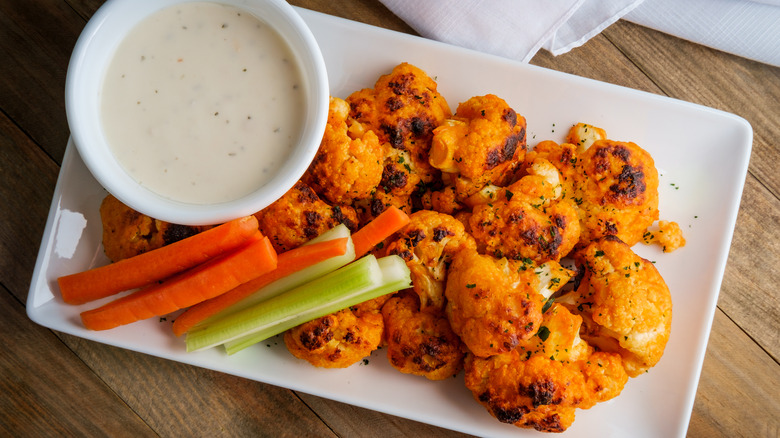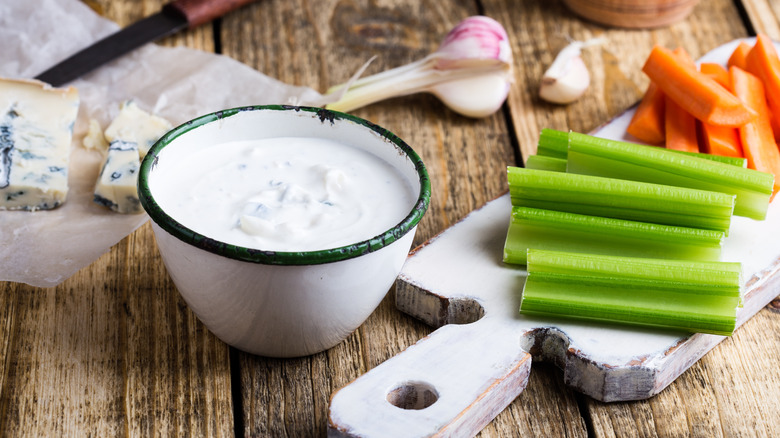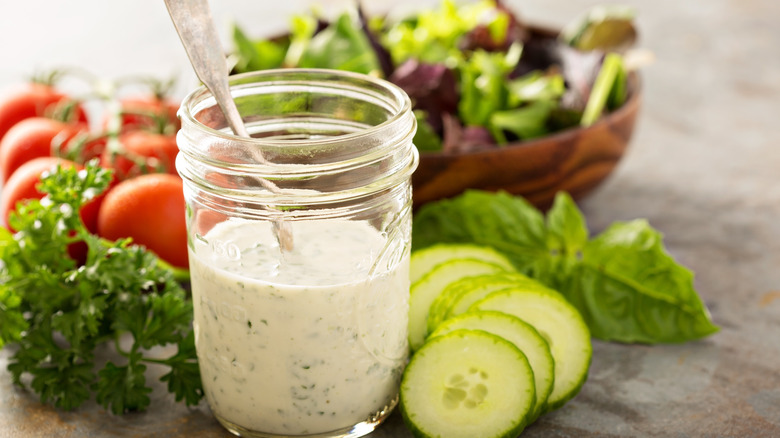Ranch Vs. Blue Cheese: The Dressings Have More In Common Than You Think
Ranch and blue cheese are both popular dressings for salad, and both are great for dipping — wings, vegetables, chips, fries, and other snacks included. The condiments are a staple in veggie trays and wing platters, and they are often served together. Many people think these dressings are the same thing, and while there are many similarities between the two, there are also some distinct differences between them.
Both blue cheese and ranch dressings have a base of buttermilk, sour cream, and mayonnaise, which gives them similar flavors. However, there are some differences in how they are made that set them apart in both taste and texture. For example, ranch dressing typically contains herbs such as dill, parsley, and chives, while blue cheese dressing contains crumbled blue cheese and vinegar. Because of these differences, ranch dressing is known for its tangy and slightly sweet flavor, as well as its creamy consistency. Blue cheese dressing, while also tangy, has more of a pungent flavor and it has a thicker consistency because of the blue cheese crumbles.
The origins of ranch and blue cheese dressings
Ranch dressing was invented in the early 1950s by a man named Steve Henson, who was a plumber in Alaska. After making the delicacy for fellow construction workers, Henson eventually moved to California and opened a dude ranch. Here, he served homemade dressing to guests. Henson started selling packets of his seasoning mix, which he called "Hidden Valley Ranch Dressing," at local grocery stores, and in the 1970s, he sold the brand to Clorox, which propelled it into popularity in the U.S.
The exact origin of blue cheese dressing is unclear, but it is believed to have originated in the U.S. in the early 20th century. One of the earliest known recordings of the recipe is found in the Edgewater Beach Hotel Salad book, dating back to 1928. However, there is also a mention of it in Fannie Farmer's 1918 book. In the Edgewater book, the recipe was called Roquefort dressing, based on the Roquefort blue cheese that was used to make it. This particular strain of blue cheese comes from France, but not all blue cheese dressings made today are created with this type of cheese.
When to choose ranch vs. blue cheese dressing
The decision to use ranch dressing versus blue cheese dressing is largely a matter of personal preference and the type of dish being served. Ranch dressing's mild flavor is a good choice for salads that feature milder or sweeter flavors, such as a Cobb salad or a salad with fruit. It's also a good choice for dipping raw vegetables, crackers, or breadsticks. Blue cheese dressing, on the other hand, has a stronger flavor, so it is a great choice for dishes that feature stronger or spicier flavors, such as spicy buffalo wings or paired with a steak. It can also add a nice flavor to burgers or sandwiches that have bold toppings.
If you are concerned about calories, though, you may want to stick with blue cheese dressing. The nutritional value of each can vary depending on the brand and type of dressing, such as traditional recipes versus fat-free varieties. However, a general comparison shows that one serving, or two tablespoons, of ranch dressing has around 140 calories, 14 grams of fat, and 2 grams of carbohydrates. Comparatively, there are only 120 calories, 12 grams of fat, and 3 grams of carbs in two tablespoons of blue cheese dressing.


